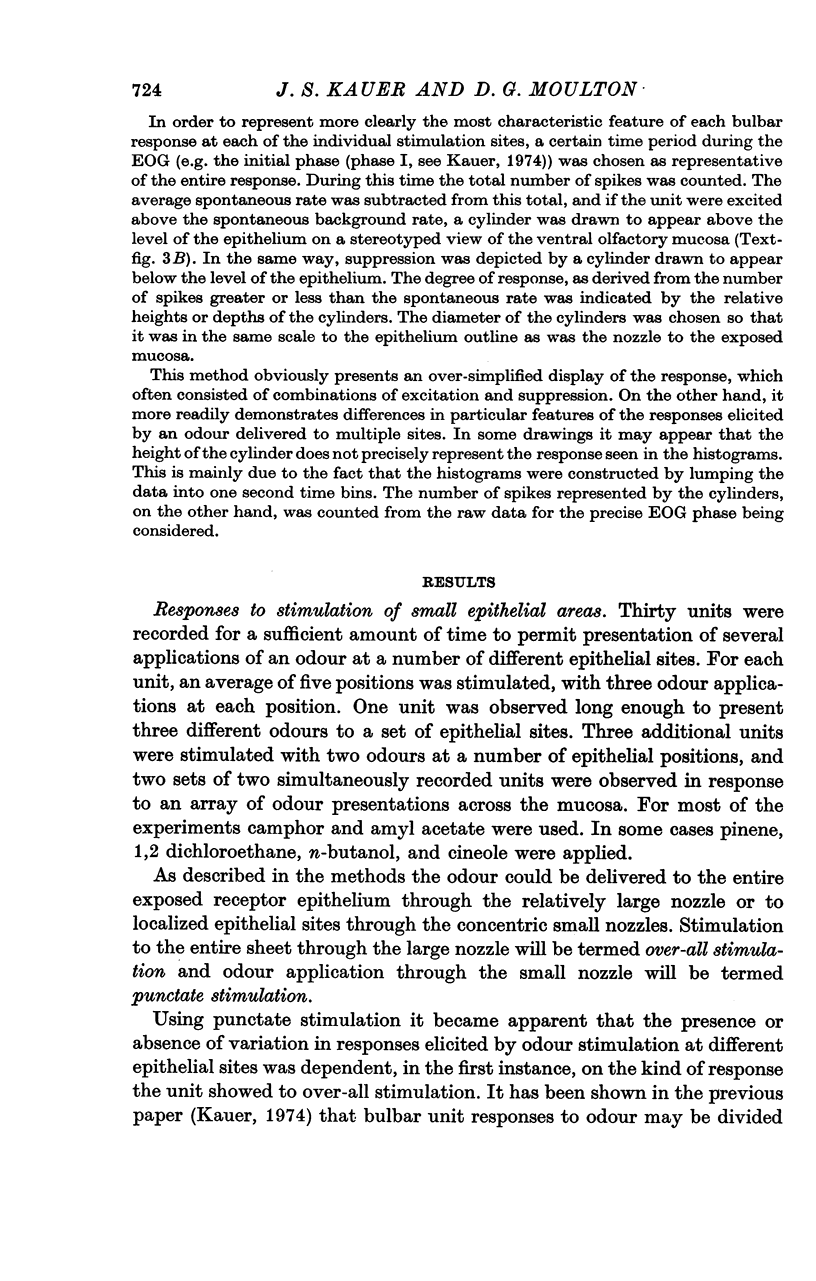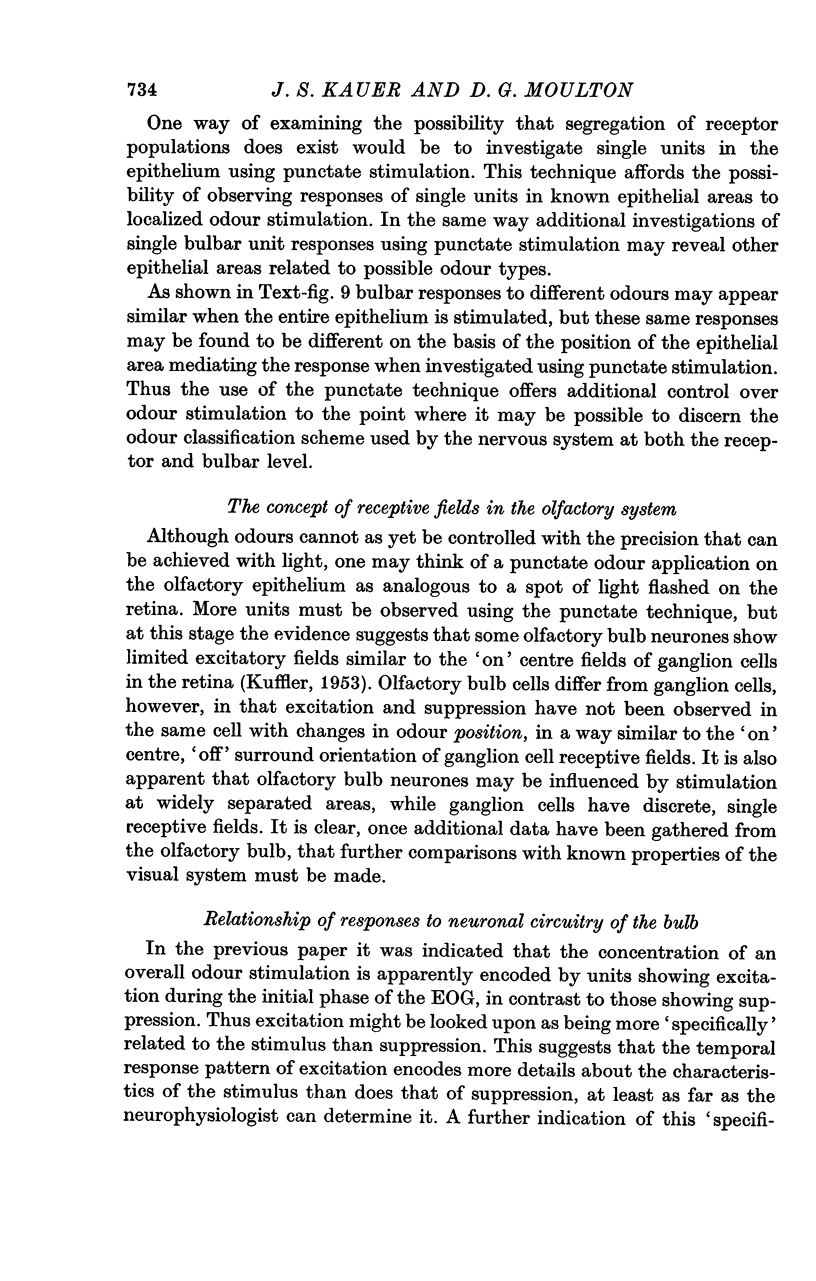Abstract
1. Previous experiments have suggested that one way odours may be discriminated is by different spatial patterns of response at both the olfactory bulb and receptor level. The present experiments were designed to test to what extent the position of an odour on the receptor mucosa can influence the activity of olfactory bulb neurones.
2. To deliver odours to small areas on the nasal receptor sheet a new method for local application of odour was developed. The flow rate, concentration, and time course of the odour were controlled using the olfactometer described in the preceding paper.
3. In thirty olfactory bulb units in the salamander it was found that if the response of a unit to odour delivered to the entire exposed receptor epithelium were suppression (type S), then the unit tended to be suppressed when odour was delivered to a number of localized epithelial regions. If the response were excitation (type E) to stimulation of the entire epithelium, then stimulation to only one or two localized regions would elicit the maximum response.
4. Different epithelial regions had the ability to cause excitation in the same bulbar unit depending on the odour being used. Two odours, camphor and amyl acetate, elicited maximum excitation when they were presented to different mucosal areas. The areas at which presentation of these odours gave excitation were surprisingly consistent from unit to unit and animal to animal.
5. The data presented here suggest the presence of restricted excitatory receptive fields for some olfactory bulb neurones for a particular odour.
6. The presence of spatial response patterns using odour delivery to small nasal receptor regions and thus the presence of receptive fields is discussed with reference to bulbar neuronal circuitry.
Full text
PDF






















Images in this article
Selected References
These references are in PubMed. This may not be the complete list of references from this article.
- ADRIAN E. D. Sensory discrimination with some recent evidence from the olfactory organ. Br Med Bull. 1950;6(4):330–333. doi: 10.1093/oxfordjournals.bmb.a073625. [DOI] [PubMed] [Google Scholar]
- ADRIAN E. D. The basis of sensation; some recent studies of olfaction. Br Med J. 1954 Feb 6;1(4857):287–290. doi: 10.1136/bmj.1.4857.287. [DOI] [PMC free article] [PubMed] [Google Scholar]
- Daval G., Leveteau J., MacLeod P. Electro-olfactogramme local et discrimination olfactive chez la grenouille. J Physiol (Paris) 1970 Nov-Dec;62(6):477–488. [PubMed] [Google Scholar]
- Gesteland R. C., Lettvin J. Y., Pitts W. H. Chemical transmission in the nose of the frog. J Physiol. 1965 Dec;181(3):525–559. doi: 10.1113/jphysiol.1965.sp007781. [DOI] [PMC free article] [PubMed] [Google Scholar]
- Graziadei P. P. Topological relations between olfactory neurons. Z Zellforsch Mikrosk Anat. 1971 Jul;118(4):449–466. doi: 10.1007/BF00324613. [DOI] [PubMed] [Google Scholar]
- KUFFLER S. W. Discharge patterns and functional organization of mammalian retina. J Neurophysiol. 1953 Jan;16(1):37–68. doi: 10.1152/jn.1953.16.1.37. [DOI] [PubMed] [Google Scholar]
- Kauer J. S. Response patterns of amphibian olfactory bulb neurones to odour stimulation. J Physiol. 1974 Dec;243(3):695–715. doi: 10.1113/jphysiol.1974.sp010772. [DOI] [PMC free article] [PubMed] [Google Scholar]
- MOULTON D. G., TUCKER D. ELECTROPHYSIOLOGY OF THE OLFACTORY SYSTEM. Ann N Y Acad Sci. 1964 Jul 30;116:380–428. doi: 10.1111/j.1749-6632.1964.tb45071.x. [DOI] [PubMed] [Google Scholar]
- MOZELL M. M. Electrophysiology of olfactory bulb. J Neurophysiol. 1958 Mar;21(2):183–196. doi: 10.1152/jn.1958.21.2.183. [DOI] [PubMed] [Google Scholar]
- MOZELL M. M., PFAFFMANN C. The afferent neural processes in odor perception. Ann N Y Acad Sci. 1954 Mar 24;58(2):96–108. doi: 10.1111/j.1749-6632.1954.tb54848.x. [DOI] [PubMed] [Google Scholar]
- Mozell M. M. Olfactory Discrimination: Electrophysiological Spatiotemporal Basis. Science. 1964 Mar 20;143(3612):1336–1337. doi: 10.1126/science.143.3612.1336. [DOI] [PubMed] [Google Scholar]
- Mozell M. M. The spatiotemporal analysis of odorants at the level of the olfactory receptor sheet. J Gen Physiol. 1966 Sep;50(1):25–41. doi: 10.1085/jgp.50.1.25. [DOI] [PMC free article] [PubMed] [Google Scholar]
- Mustaparta H. Spatial distribution of receptor-responses to stimulation with different odours. Acta Physiol Scand. 1971 Jun;82(2):154–166. doi: 10.1111/j.1748-1716.1971.tb04954.x. [DOI] [PubMed] [Google Scholar]
- O'Connell R. J., Mozell M. M. Quantitative stimulation of frog olfactory receptors. J Neurophysiol. 1969 Jan;32(1):51–63. doi: 10.1152/jn.1969.32.1.51. [DOI] [PubMed] [Google Scholar]
- OTTOSON D. Some aspects of the function of the olfactory system. Pharmacol Rev. 1963 Mar;15:1–42. [PubMed] [Google Scholar]
- PHILLIPS C. G., POWELL T. P., SHEPHERD G. M. RESPONSES OF MITRAL CELLS TO STIMULATION OF THE LATERAL OLFACTORY TRACT IN THE RABBIT. J Physiol. 1963 Aug;168:65–88. doi: 10.1113/jphysiol.1963.sp007178. [DOI] [PMC free article] [PubMed] [Google Scholar]
- Rall W., Shepherd G. M. Theoretical reconstruction of field potentials and dendrodendritic synaptic interactions in olfactory bulb. J Neurophysiol. 1968 Nov;31(6):884–915. doi: 10.1152/jn.1968.31.6.884. [DOI] [PubMed] [Google Scholar]
- Reese T. S. OLFACTORY CILIA IN THE FROG. J Cell Biol. 1965 May 1;25(2):209–230. doi: 10.1083/jcb.25.2.209. [DOI] [PMC free article] [PubMed] [Google Scholar]
- SHEPHERD G. M. NEURONAL SYSTEMS CONTROLLING MITRAL CELL EXCITABILITY. J Physiol. 1963 Aug;168:101–117. doi: 10.1113/jphysiol.1963.sp007180. [DOI] [PMC free article] [PubMed] [Google Scholar]
- SHEPHERD G. M. RESPONSES OF MITRAL CELLS TO OLFACTORY NERVE VOLLEYS IN THE RABBIT. J Physiol. 1963 Aug;168:89–100. doi: 10.1113/jphysiol.1963.sp007179. [DOI] [PMC free article] [PubMed] [Google Scholar]





